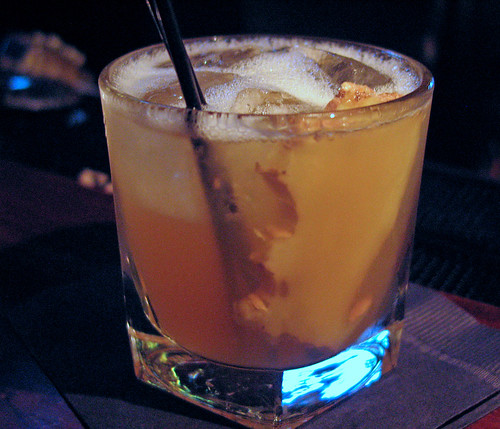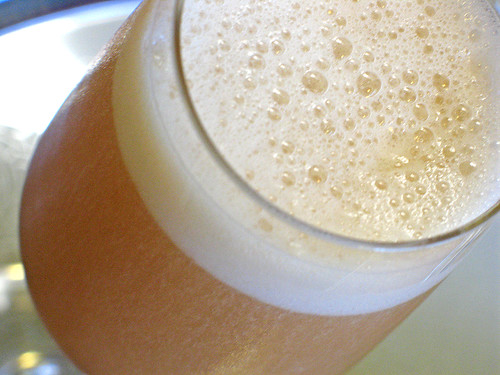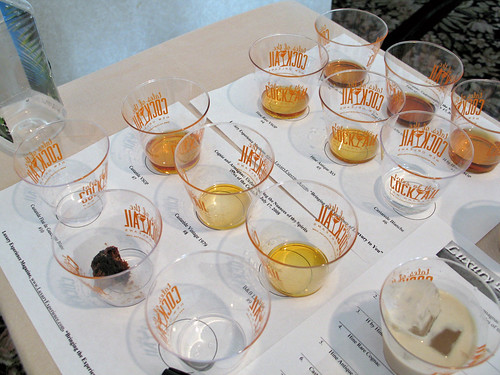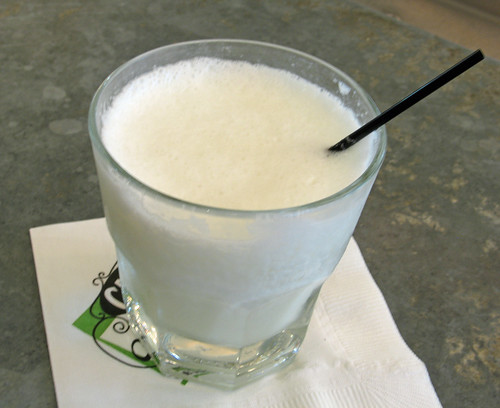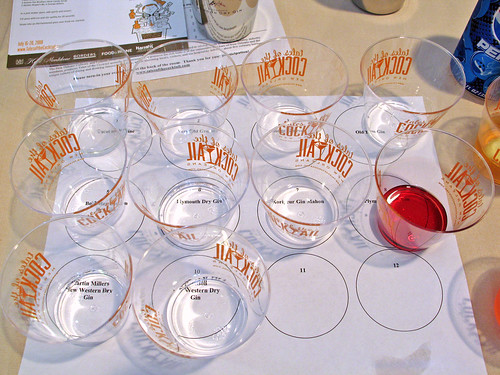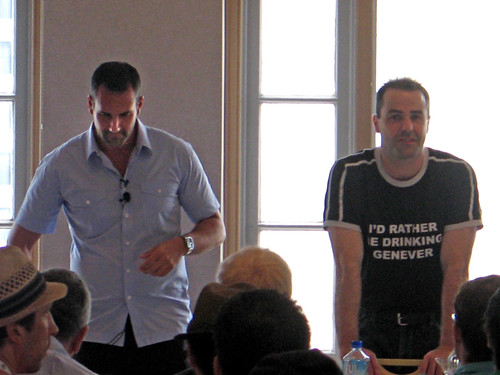Mixology Monday XXX: Local Flavor
Yeesh, so soon already! Well, we did get a week’s extension on MxMo XXIX last month, in order for our brains and livers to recover from Tales of the Cocktail, and August’s has crept up on us already. This month we’re hosted by Kevin Kelpe, a bartender and restauranteur in Boise, Idaho and author of the drinking blog Save the Drinkers. It was great to see Kevin at Tales again this year, and I’m comforted in the knowledge that if we stop through Boise we know where we can go to get a damn good drink.
The theme this month is local flavors, and Kevin puts it thusly:
Option 1: Gather ingredients that are representative of the culture/geography/tackiness of your respective cities and make a drink with a truly place-based style. For example, huckleberries are native to the geographical area where I live, as are elderflowers, potatoes, and extremely conservative, closet-case politicians. (I’m just saying!)
Option 2: Dig up an old drink that came from your city and revive it! If you can find the original bar, that would be even more interesting.
I really wanted to do option 1, given the bounty that’s in my own backyard. We have a very old fig tree that’s brimming with fruit right now, absolutely stunning figs more than half the size of your fist. I’ve been brewing an idea back in me brain to make some fig-infused Bourbon, using both fresh figs from my garden and dried Mission figs to give it a greater depth of flavor. By the time I finally read Kevin’s post there was no way I’d have that ready for MxMo XXX, so it’s going to have to wait a few weeks. We also have a large grove of pomegranates, but they won’t be ready until late fall / early winter at the earliest.
So I’m gonna go for a variation on option 2, digging up a couple of new drinks that come from our city, and I’m gonna be Mr. Overachiever as I did last month and post two. They’re terrific drinks from the same bar, the bar that really did the most to kick off the cocktail renaissance in Los Angeles, and were created by Los Angeles bartenders for Los Angeles; one of them is also a nod to that bar’s long history … as a jeweler in the 1920s.
You’ve undoubtedly heard me and many others was poetic about this Los Angeles bar; Seven Grand is one of our favorite places to drink in the city, in a year where we suddenly actually had places to drink in the city other than our house. Los Angeles had been pretty much a big zero in the quality and classic cocktail world for ages, and all of a sudden 2007 saw us take off like a Saturn V rocket. We fell in love with this bar right away, even though we didn’t get our procrastinatory asses in there until they had already been open for four months, and we still love it. The key to Seven Grand is to go on Sundays through Wednesdays, earlier in the evening, when you can get personalized attention from their bartenders; John, Leo and the rest of the guys will take very, very good care of you.
They’ve just streamlined their cocktail menu (I was JUST there the other day and forgot to take a look at it, d’oh), but today I’ll offer you two of Seven Grand’s house cocktails that were on their early menu last year, and if either of them aren’t on it at the moment (which I doubt), surely they can still make it for you … or now you can make it yourself.
The first is named after the original occupants of the beautiful 1921 building in which the bar is housed. Brock & Company were a prominent jeweler in Los Angeles, and although their days are long gone they still live on at Seven Grand. Many of the architectural and interior details of the old space were reused in the design of the new — the glass jewelry cases formed a bank of small windows near the ceiling in the room divider, wooden jewelry drawer fronts with gorgeous brass handles were mounted on the front of the bar, and the beautiful polished wood surface of the bar itself came from the boardroom table. Then there’s this very, very tasty drink named after the original occupants; I think they’d have to find it as tasty as I do.
Brock & Co.
2 ounces Knob Creek Bourbon whiskey.
1/2 ounce ginger-infused syrup.
1/2 ounce “runny” honey (or 2:1 honey syrup)
3/4 ounce fresh lemon juice.
1/2 ounce orange juice.
Long, thin ginger slice for garnish.Combine ingredients in a cocktail shaker with ice. Shake vigorously, then pour into an Old Fashioned glass over fresh ice. Garnish with the ginger slice.
Bright, tangy, summery, refreshing, and a great drink for quenching your thirst over the next couple of months when it’s gonna be HOT.
If you don’t have ginger syrup you can substitute Massenez Crème de Gingembre or Domaine de Canton ginger liqueur.
The next is another of Seven Grand’s house cocktails, and although it may not feature local ingredients per se, it’s named for our great city. [UPDATE: There’s a bit of history here too; a quite similar cocktail appears in Harry Craddock’s Savoy Cocktail Book from the 1930s, which I had completely forgotten about (and thanks to Erik and Anita for reminding me of this in the comments). This is is a slightly modernized adaptation; I’m assuming that it was the inspiration for this local version.] I suppose calling it the El Pueblo de Nuestra Señora la Reina de Los Angeles de Porciúncula Cocktail might be a bit unwieldy, so they wisely opted to stick with the shorter, more colloquial name for the city and the drink. This is the way I make it, with my preferred Bourbon these days; use the one you like best.
The Los Angeles Cocktail
(House version served at Seven Grand)1-1/2 ounces Buffalo Trace Bourbon whiskey.
3/4 ounce simple syrup.
1/2 ounce fresh lemon juice.
1/4 ounce Vya sweet vermouth.
1 egg white.
1 dash Angostura Bitters.Add the egg white to the shaker and shake like hell for at least 10 seconds alone, WITH NO ICE. Add the rest of the ingredents, then plenty of ice, and shake like hell for at least 15 seconds. Strain into a sour glass, wine or port glass, or something elegant.
This one’s reeeeeally nice. It’s basically a whiskey sour with a bit of spice added to it from the vermouth and the bitters; I like to keep this one in the California family by using Vya, a wonderfully spicy sweet vermouth made in California. Substitute Punt E Mes or Carpano Antica, if you can find them.
I’m gonna be a royal pain in the ass by throwing in a third drink, which although has the same name as a venerable, famous landmark Los Angeles restaurant of yesteryear, and the same name as that restaurant’s house cocktail … it ain’t that cocktail, and wasn’t served at that restaurant. I just like it, and the name makes it sound local, so there.
Dave Wondrich describes it thusly:
Fact is, we can’t find a damn thing about this perfectly charming drink, and the Second Law of Mixography dictates when all else fails, discuss the drinking habits of our ancestors. (The First Law? Hemingway probably drank it.) What we know: The Brown Derby appears in Esquire’s June 1939 “Potables” column. Before that, nothing. After that, nothing. Did it come from Robert Cobb’s famous Brown Derby restaurant in Hollywood? There is a Brown Derby cocktail we’ve seen connected to the eatery — but it ain’t this. (And what would they be doing messing around with maple sugar out there in sunny California, anyway?) Or is the name just because it’s brown?
The only spar we’ve got to cling to in this sea of ignorance comes in the unlikely form of roly-poly Alexander Woollcott (the guy on whom Sheridan Whiteside in The Man Who Came to Dinner was based). In 1935, he turns up in So Red the Nose, an odd little book in which famous writers of the day contributed their favorite drinks, all renamed after their latest books. Woollcott’s When Rome Burns is essentially the Brown Derby, but with lemon juice instead of the lime and maple syrup instead of maple sugar, and with the key specification that you use Medford rum. They don’t make that anymore, either. But when they did, they made it in Medford — right outside of Boston. So. The Brown Derby, or whatever you want to call it? New England’s answer to the daiquiri. It might not be tropical, but it sure is tasty.
Oh yeah, that other Brown Derby? Jigger of bourbon, half-jigger of grapefruit juice, teaspoon or so of honey (stir ’em all together before you add the ice). Let us know how it turns out.
The Brown Derby Cocktail
2 ounces Jamaican rum (I like Appleton Estate V/X in this).
1 ounce fresh lime juice.
1 teaspoon grade-B maple syrup.Shake and strain.
Thanks to Dan Reichert for turning me on to this one. The original recipe, as Dave mentioned, called for maple sugar, but maple syrup’s a lot easier and cheaper to obtain, and grade-B maple syrup is such a terrific cocktail ingredient it should be used more often anyway.
Okay, so, that was really four drinks, if you include the recipe for the Brown Derby Restaurant’s actual house cocktail; told you I was a pain in the ass.
Happy Mixology Monday! Now get drinking.

